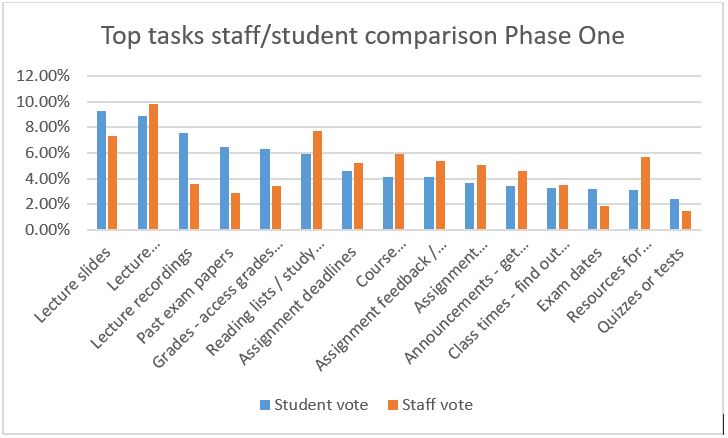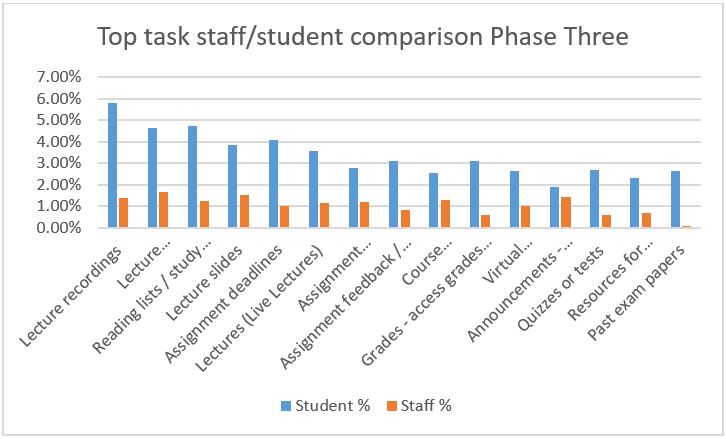A top tasks survey has shown what staff and students prioritise in hybrid teaching and learning
Staff and students completed a top tasks survey as part of the Learn Foundations research. This helped us understand what is most important to them when they use Learn for teaching and learning in the hybrid context.
We carried out research to re-evaluate what was important to staff and students when they use Learn. This study formed part of Phase Three of Learn Foundations – a project which aims to ensure Learn provides the best possible user experience to staff and students. Earlier phases of the project had already investigated staff and students’ top tasks in Learn, but it was important to revisit this with the move to hybrid teaching and learning. The top tasks survey was one of the quantitative pieces of research carried out in Phase Three. It formed part of a wider programme of research including a card sort, usability tests and semi-structured interviews.
Read an overview of the Phase Three Learn Foundations research in the separate blog post:
Understanding what staff and students need from Learn for hybrid teaching and learning
Top tasks in Phase One of Learn Foundations
The top tasks survey method was pioneered by Gerry McGovern and is a tried-and-tested way of identifying what users need from a product or service. In the survey, people are presented with a list of things they can use the product or service for and asked to pick those they consider most important. Results from a top tasks survey typically identify a small percentage of tasks that are of top priority to users, with the remaining tasks being significantly less important.
In Phase One of Learn Foundations, carried out pre-Covid-19, the survey revealed the items of most value to students when using Learn were to do with lectures – for example lecture notes and slides. Staff also voted ‘Lecture notes/slides and handouts’ as one of their top tasks, with reading lists and course curricula appearing high on their list of priorities.
You can read about the Phase One survey and the results in a separate blog post by Duncan Stephen:
Top tasks surveys have identified what really matters to students using Learn
Learn Foundations template – helping the transition to hybrid
The top tasks survey in Phase One of the project helped inform the development of a Learn template to support staff and students’ needs consistently across the Schools and Deaneries of the University. The template was produced after extensive research with staff and students to discover how they used and expected to use Learn, and it contains the following nine ‘core’ menu items to support task-based navigation of the interface:
- Welcome
- Course Information
- Announcements
- Course Materials
- Library Resources
- Assessment
- Course Contacts
- Have Your Say
- Help and Support
In addition to these core items, the template includes an optional ‘plus two’ menu items, designed to be adapted by Schools to customise the interface to meet specific contextual needs.
In Phase Two of the project, 10 Schools and Deaneries signed up to adopt the template. As the Covid-19 pandemic took hold, this increased to 20 Schools. The template played a crucial part in helping Schools make the transition to hybrid teaching and learning.
Are top tasks the same in the hybrid context?
The purpose of carrying out another top tasks survey (during the Covid-19 era) was to help us understand whether there had been any changes in staff and students’ priorities when using Learn for hybrid teaching and learning.
By analysing the findings from the Phase Three research in relation to what we found in Phase One, we could start to build a picture of the use of Learn in the hybrid context, and understand if the Learn Foundations template was still serving the purpose it had been developed for.
Tweaking the survey design for hybrid
The top tasks survey presented students and staff with a list of 50 tasks they could complete using Learn, and asked them to pick the top five most important to them when accessing/uploading/creating learning materials online. Examples of items in the list included: ‘Lecture slides’, ‘Assignment feedback’, ‘Course curriculum’, ‘Reading lists’, etc.
The list of tasks included in the Phase Three survey was adapted from the list of 46 items contained in the Phase One survey. Four additional items were added to the list, one (‘Office Hours’) because feedback from students interviewed in Phase One indicated this was an item they would expect to find, and three to reflect the hybrid context. These were:
- Lectures (Live lectures)
- Virtual Classroom/Seminar (Live Seminar)
- Help Using Learning Technology Tools
The original 46 items contained one fewer than the list of items included in the other piece of quantitative research, the card sort – this item was ‘Course handbook’, which was not considered a ‘task’.
Response from staff and students
461 people completed the survey, comprising 330 students and 131 staff. The response was very pleasing given fatigue levels among staff and student populations were high due to the effects of being in lockdown because of the pandemic. It was encouraging to receive responses from all 24 Schools and Deaneries, and to see that the split between student and staff responses was approximately the same as before (in Phase One there was an approximate split of 80% students to 20% staff, whereas in Phase Three there was an approximate split of 70% students to 30% staff).
The results were analysed to understand which tasks were the ‘top’ tasks for students and staff. This involved looking at which items received the most votes from students, compared to those which received most votes from staff. These findings were compared to the results from the Phase One survey, to understand how staff and students’ top tasks had changed.
Students’ top tasks have remained constant
From the Phase One research the top eight tasks voted for by students with the percentage of total votes they received were as follows:
- Lecture slides – 9.3%
- Lecture notes/outlines/handouts – 8.9%
- Lecture recordings – 7.6%
- Past exam papers – 6.5%
- Grades – access grades for courses – 6.3%
- Reading lists/study resources – 5.9%
- Assignment deadlines – 4.6%
- Assignment feedback/feed forward – 4.1%
From Phase Three the top eight tasks students voted for, with the percentage of total votes were as follows:
- Lecture recordings – 5.80%
- Reading lists/study resources – 4.72%
- Lecture notes/outlines/handouts – 4.64%
- Assignment deadlines – 4.10%
- Lecture slides – 3.87%
- Lectures (Live Lectures) – 3.89%
- Assignment feedback/feed forward – 3.13%
- Grades – access grades for courses – 3.13%
Seven out of the top eight tasks identified by students in Phase One were present in the top eight tasks identified in the Phase Three study. This suggests that students’ needs have not changed, regardless of the current situation. Students still wish to use Learn to find the same things as they did before the shift to hybrid.
Staff top tasks slightly changed
In Phase One of the research, the top eight tasks voted for by staff with the percentage of total votes they received were as follows:
- Lecture notes/outlines/handouts – 9.8%
- Reading lists/study resources – 7.7%
- Lecture slides – 7.3%
- Course curriculum/outline/syllabus – 5.9%
- Resources for preparing for seminars/tutorials/labs/practicals – 5.7%
- Assignment feedback/feed forward – 5.4%
- Assignment deadlines – 5.2%
- Assignment submission/upload submit work for marking – 5.1%
From Phase Three the top eight tasks staff voted for, with the percentage of total votes were as follows:
- Lecture notes/outlines/handouts – 1.66%
- Lecture slides – 1.55%
- Announcements – Send/get updates from course – 1.43%
- Lecture recordings – 1.39%
- Course curriculum/outline/syllabus – 1.28%
- Reading lists/study – 1.24%
- Assignment submission/upload – Submit work for marking – 1.20%
- Lectures (Live Lectures) – 1.16%
Five out of the top eight tasks identified by staff in the Phase One iteration of the survey had changed in the Phase Three results, showing that different items were more important to staff in the hybrid context than they were before. This suggests staff have had to change their thinking in order to deliver hybrid teaching. In particular, the item ‘Announcements’ had grown in importance to staff in the hybrid set-up.
Comparing students and staff top tasks
The charts illustrate the top 15 tasks voted for by staff compared to those voted for by students. Staff responses are represented by the blue columns, students’ responses by the orange columns.


There are several similarities with the data from the Phase One survey (such as ‘Announcements’ being important for staff but students not placing anywhere near as much importance or emphasis on this task).
Comparing the Phase One chart to the Phase Three chart, it is clear that staff needs and students’ needs from Learn have changed differently in the light of hybrid teaching and learning.
While students’ needs from Learn stayed the same, staff needs and priorities changed as they adapted to use Learn to deliver teaching through new processes and methods.
Stability in top tasks suggested template still valid
The top tasks identified by staff and students in Phase Three of Learn Foundations were strikingly similar to those identified in the first Phase One. Despite the shift to hybrid teaching and learning, students’ needs from Learn more or less stayed the same. They still valued items to do with lectures above all else.
Staff priorities had shifted slightly with the move to hybrid, with ‘Announcements’ and ‘Lecture recordings’ being voted more important than they were in the pre-Covid-19 survey.
This shift was to be expected as it reflected how staff were adapting to delivering teaching differently. It did not suggest the need to change the template, instead it demonstrated that the template was sufficiently robust and adaptable to be used in a new way to accommodate changing practices.
As practices continue to evolve in hybrid, Schools may make use of the adaptable ‘plus two’ menu items in the template, and also may seek to customise the structure within the main menu items to suit their specific needs.
More blogs about Learn Foundations user research
Phase Three Learn Foundations has included both qualitative and quantitative research. You can read about the full programme of research in a separate blog post:
Understanding what staff and students need from Learn for hybrid teaching and learning
Details and results of the card sort study are included in this post:
A card sort study has revealed how students expect to navigate Learn for hybrid learning
Information about the research and findings from the Phase One Learn Foundations user experience programme are included in Duncan Stephen’s post:


3 replies to “A top tasks survey has shown what staff and students prioritise in hybrid teaching and learning”